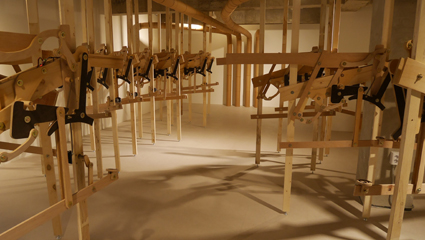Searching for the Letters Swallowed by a Ghost

Description
Summary of Exhibition
The exhibition features the device of typewriter letters hitting the walls, pipes extending to the floor, ceiling, and various walls, along with electric units signaling Morse code. The appearance of the spaces installed together, seemingly not connected, relates to a narrative structure, which is gradually revealed by the narrator's voice and sound.
Inspiration
Kafka believed that if a letter did not arrive, it meant that a demon had seized it. When he needed to meet her, his anxiety about the meeting would cause him to throw himself onto the path toward her, only to collide with a cliff, necessitating the digging of a new path. When he felt deep doubts about his obsessive relationship with letters, he expressed that “the letter has always deceived me—especially the letters I wrote myself. The ease of writing letters surely brings about a chilling confusion of the soul in a theoretical sense. This is a communication with a ghost, not just with the ghost as a recipient of the letter but also with one's own ghost.”
He also stated that “the kiss written in a letter fails to reach its destination and is entirely consumed by a ghost along the way; the ghosts that devour the letters proliferate immensely, and humanity invents railroads, cars, and airplanes to combat this, yet the opposing force grows even stronger, leading to the inventions of telegraphy, telephony, and wireless telegraphy, ultimately resulting in the ruin of humanity.”
Installation and directing
The installation begins with devices created solely from typing part of the typewriter. These are made on a large scale to match the number of characters, and each letter punches the walls, creating holes rather than printing.
While the devices do not break though the exhibition walls, it visualizes a pneumatic postal structure that connects passageways within the walls. This evokes an image of the burrow-like passageways through which Kafka, in his anxiety about meeting Milena, is thrown into the passageway to her, signaled “please don't come,” and forced to go back and dig another one. In the artist’s imagination, this burrow also serves as a wormhole capable of transcending time and space.
The exhibition incorporates excerpts from Kafka’s letters to Milena, enriched with the artist's imagination—a narrative wherein Kafka/His ghost, enters the postal passageways in search of Milena in a world undefined by time and space, narrated by the voice of the narrator.
The spatial installation of the typewriter letter elements and the pipes, along with small LED lights transmitting Morse codes, combines with the sounds of the typewriter's operation, the narrator's voice, music, to create a bizarre stage setup. This setup becomes a dramatic tableau led by Kafka/His ghost.
Exhibition Credits
Machine building and Installation Team Leader
Sungjin Jang
Installation Assist
Seunghwan Baek, Hyoduck Hwang, Yoonsu Lee
Paper tube Fabrication
Kieun Baik
Paper tube Fabrication Assist
Sooyeon Kang, Jungwha Jung
Narrator Actor
Myungwon Jung
Soundtrack and Music
Siegfried Koepf
Poster Design
Yongseok Park
Special thanks
Namdeuk Kwon, Jayeon Kwon, Sungwon Park, Yongseok Park, Sangbin Im, Geunah Lim
Related Text
"Artist's note on the exhibition : Searching for the Letters Swallowed by a Ghost", Jungwha Jung
Exhibition
October 11–29, 2024, "Searching for the Letters Swallowed by a Ghost", NOTHINGISREAL X Art these days, Seoul